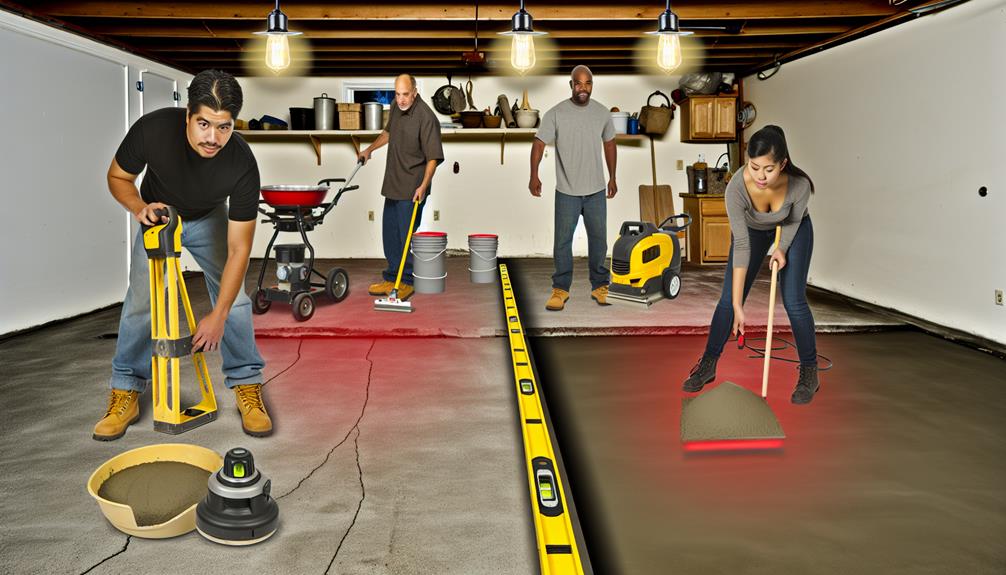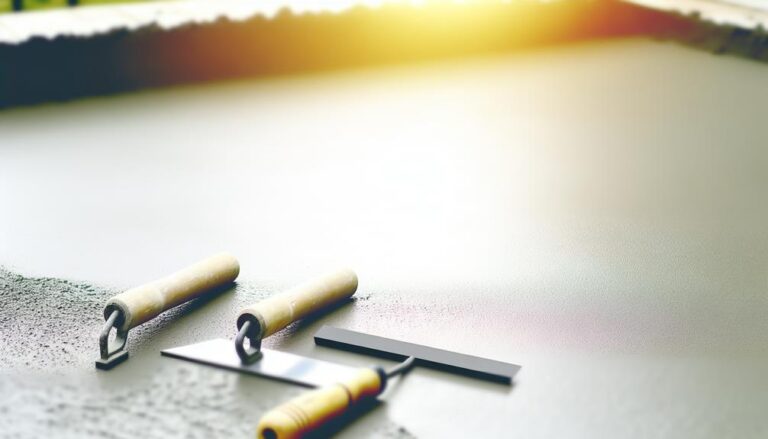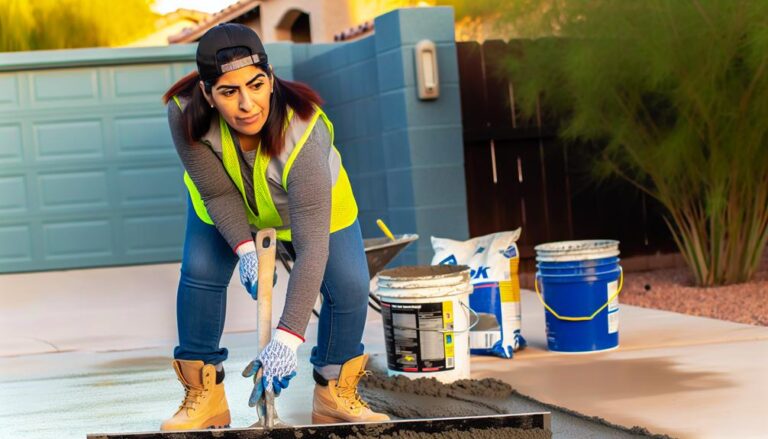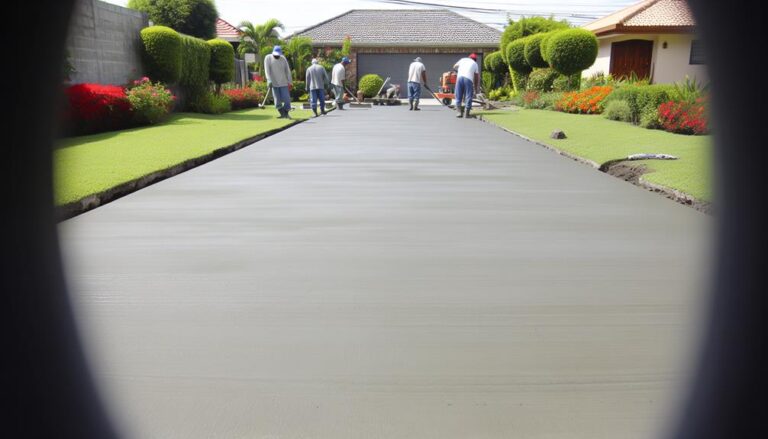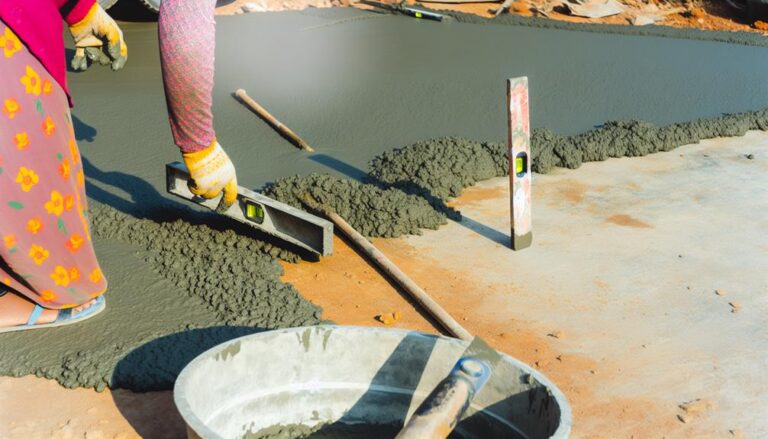What Are the Best Methods for Concrete Leveling?
To level concrete, you can choose from several effective methods depending on your specific needs. Self-leveling compounds are quick and efficient for floors. Mudjacking is cost-effective for lifting sunken slabs. Polyurethane foam injection offers a modern and rapid-curing solution. Grinding and polishing level and enhance surfaces, while concrete resurfacing rejuvenates damaged areas. Each method has its own advantages and is best suited for different situations. To make the best choice, you'll want to take into account factors like cost, time, and the condition of your existing concrete. Explore these methods further to find the ideal solution for your project.
Self-Leveling Compounds
Self-leveling compounds offer a quick and efficient way to create a smooth, even surface on concrete floors. If you've got an uneven or damaged surface, this method can save you time and effort.
First, make sure the floor is clean and free of debris. Next, you'll need to mix the self-leveling compound according to the manufacturer's instructions. It's essential to get the right consistency, so don't rush this step.
Once your mixture is ready, pour it over the concrete surface. Use a long-handled squeegee or trowel to help spread the compound evenly. It's designed to flow and level itself out, so you won't need to worry much about meticulous spreading. The compound will seek out low spots and fill them in, creating a level surface.
After pouring, the compound will take some time to cure. Depending on the product, this can range from a few hours to a day. Make sure you allow it to fully set before walking on it or adding any additional flooring.
This method is particularly effective for minor leveling issues and leaves you with a smooth, ready-to-use surface.
Mudjacking Technique
Mudjacking offers a cost-effective solution for lifting and leveling sunken concrete slabs. If you've noticed uneven sidewalks, driveways, or patios around your property, mudjacking can address these issues efficiently.
The process involves drilling small holes into the affected concrete and then pumping a slurry mixture of water, soil, and cement through these holes. This slurry fills the voids beneath the slab, lifting it back to its original position.
One of the main benefits of mudjacking is its affordability compared to complete slab replacement. You won't need to tear out and pour new concrete, saving both time and money. Additionally, mudjacking is minimally invasive. The small holes drilled into the slab are easily patched up, leaving your concrete looking almost like new.
Mudjacking is also quick. Most jobs can be completed in just a few hours, and the concrete is usually ready for use within a day. This technique works well for various applications, including driveways, sidewalks, patios, and even basement floors.
However, it's important to have a professional perform the mudjacking process to ensure the correct slurry mixture and proper application, ensuring long-lasting results.
Polyurethane Foam Injection
Polyurethane foam injection offers a modern and efficient method for leveling uneven concrete surfaces. You'll find this technique particularly beneficial for its speed and minimal disruption. To start, small holes are drilled into the concrete. Then, a specialized foam is injected through these holes. As the foam expands, it fills voids beneath the slab, lifting and leveling the concrete in the process.
One of the advantages of polyurethane foam injection is its rapid curing time. Within just 15 minutes, the foam hardens, allowing you to use the leveled surface almost immediately. This means less downtime and quicker project completion. Additionally, the foam is lightweight yet strong, which reduces the risk of further settling.
You'll also appreciate that polyurethane foam is water-resistant. It doesn't erode over time, making it a durable solution for areas prone to moisture. The accuracy of this method ensures that the concrete is lifted evenly, avoiding the risk of cracking or further damage.
Plus, the process is relatively clean, with minimal mess compared to other methods.
Grinding and Polishing
Grinding and polishing offer a straightforward yet effective method for leveling and enhancing the appearance of concrete surfaces. You'll need specialized equipment like a concrete grinder and diamond polishing pads to get started. This method is great for removing imperfections, achieving a smooth finish, and giving your concrete a polished look.
Here's a simple breakdown of the process:
- Grinding: First, you'll use a concrete grinder to level out the surface. Start with a coarse-grit diamond pad to remove high spots and imperfections. Move systematically across the entire area to make sure even grinding.
- Polishing: Once the surface is level, switch to finer grit pads to begin polishing. This step smooths out any remaining roughness and brings out the shine in the concrete. You can choose how polished you want the surface to be by advancing through finer grits.
- Sealing: After polishing, it's a good idea to apply a concrete sealer. This helps protect the surface from stains and wear, guaranteeing your polished concrete stays looking great for years to come.
Concrete Resurfacing
Concrete resurfacing offers a cost-efficient method to rejuvenate worn or damaged concrete without the need for a complete replacement. It's an excellent option if you're dealing with surface-level imperfections like small cracks, discoloration, or minor pitting. By applying a thin layer of a specialized overlay, you can bring new life to your concrete surfaces, making them look practically brand new.
The process starts with thoroughly cleaning the existing concrete to remove dirt, debris, and any loose material. Next, you apply a primer to guarantee the overlay adheres properly. After that, the resurfacing compound is mixed and spread evenly across the surface. Finally, you can add decorative finishes, such as stamping or coloring, to achieve the desired look.
Here's a quick comparison of the pros and cons of concrete resurfacing:
| Pros | Cons |
|---|---|
| Cost-efficient | Not suitable for major damage |
| Quick application | Requires proper preparation |
| Can add decorative finishes | Limited to surface-level issues |
Concrete resurfacing is a great choice if you want to extend the life of your concrete without breaking the bank. Always make sure you're following the right steps for preparation and application to achieve the best results.
Pressure Grouting
Pressure grouting is a highly effective method for stabilizing and leveling concrete surfaces by injecting grout into voids beneath the slab. This technique involves drilling small holes in the concrete and then pumping a specialized grout mixture under pressure. The grout fills the gaps, compacts loose soil, and lifts the slab back to its original position.
You'll find this method useful for addressing a variety of issues, from minor settling to significant voids caused by erosion.
Here's a quick rundown of the key steps involved in pressure grouting:
- Drill Holes: Small holes are drilled strategically through the concrete slab to access the voids underneath.
- Inject Grout: A grout mixture is pumped through these holes under high pressure, filling the voids and stabilizing the soil.
- Seal Holes: Once the slab is leveled, the holes are sealed with a concrete patch to restore the surface.
Pressure grouting works well for both residential and commercial properties, and it offers a long-lasting solution to concrete settling problems. It's also less invasive compared to other methods, making it a preferred choice for many. If you're dealing with uneven concrete, pressure grouting might just be the fix you need.
Slab Jacking Methods
Slab jacking, a versatile and efficient method, involves lifting sunken concrete slabs by injecting a slurry mixture beneath them. You'll find this technique particularly useful for addressing uneven driveways, patios, and sidewalks.
The process starts by drilling small, strategically placed holes in the affected area. Through these holes, a specialized slurry—usually a mixture of cement, sand, and other additives—is pumped under high pressure. This slurry fills voids and raises the slab to its original level.
One advantage of slab jacking is its speed. You can often complete the entire process in just a few hours, and the area is usable almost immediately. It's also a cost-effective alternative to replacing the entire slab, saving you money and reducing material waste. Additionally, slab jacking doesn't require large-scale excavation, so it's less disruptive to your property.
However, it's important to verify that the underlying soil conditions are stable. If the soil continues to settle, you might need additional slab jacking in the future. Always consult a professional to assess whether slab jacking is suitable for your specific situation.
Frequently Asked Questions
How Long Does It Take for Concrete Leveling Methods to Cure?
Curing time for concrete leveling methods varies.
If you use self-leveling compounds, they typically take about 24 hours to cure.
Mudjacking might need a couple of hours to a few days, depending on the mixture and conditions.
Polyurethane foam injections cure faster, usually within 15 minutes to an hour.
Always check the product instructions and environmental factors for accurate curing times.
Don't rush the process for the best results.
Are There Eco-Friendly Options for Concrete Leveling?
Oh, you care about the environment, do you? Well, aren't you just a hero!
Yes, there are eco-friendly options for concrete leveling. You can use recycled materials like fly ash or slag cement. Plus, some companies offer polyurethane foam made from renewable resources.
Can Concrete Leveling Be Done in Cold Weather?
Yes, you can level concrete in cold weather, but you'll need to take extra precautions. Use cold-weather additives to guarantee the concrete sets properly. Keep the area covered and insulated to maintain an adequate temperature.
Heaters can also help, but don't let them overheat the concrete. Monitoring the weather forecast and planning ahead will make the process smoother and more effective.
How Much Does Concrete Leveling Typically Cost?
You're probably wondering about the cost of concrete leveling. Generally, it varies depending on factors like the size of the area and the method used. On average, you might spend between $500 and $1,500.
Smaller jobs can be cheaper, around $300, while larger or more complex projects might go up to $2,000 or more. It's best to get a few quotes to find the most accurate price.
What Are the Signs That My Concrete Needs Leveling?
You'll notice your concrete needs leveling when it starts showing cracks, uneven surfaces, or pooling water after rain.
Door and window frames mightn't close properly, and you could trip over raised sections.
Pay attention to furniture wobbling or gaps forming between the concrete and adjacent structures.
These signs indicate that your concrete has shifted and needs immediate attention to prevent further damage or safety hazards.
